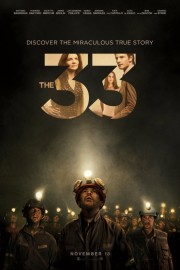The 33
On August 5, 2010, 33 gold miners in Chile went into a mine run by the San Jose Mining Company. As the film, “The 33,” tells it, the foreman at the mine, Castillo, knew that the mountain the mine was in was unsafe for work, but for financial reasons, he ordered the person in charge of the men, Don Lucho (played by Lou Diamond Phillips), to get them down there anyway. Not long after they are in the mine, a cave-in happens, trapping all of the miners. As word gets around to the families, they descend on the site, only to find that the Company does not appear to have much motivation to try and rescue them. Even when a government official (Laurence Golborne, played by Rodrigo Santoro), who appears to have no experience as a miner himself (despite being the Minister of Mining), arrives to the site, all seems hopeless for the trapped men, who have wives, children, parents and brothers and sisters waiting for them to be rescued. Fortunately for them, Golborne has a drive to get these men home that goes beyond politics, and when he is joined on site by one of the best drillers in the world (Andre Sougarret, played by Gabriel Byrne), there may be hope yet for them, although the wait for a breakthrough alone may kill them.
Although this is a remarkable true story, and I remember somewhat following the ordeal when it took place five years ago, my main interest in Patricia Riggen’s film, which is a well-made piece of docudrama, with a great cast that includes Antonio Banderas, Juliette Binoche and James Brolin, among many others, was a musical one. When the film started, I almost immediately began focusing on the score for the film by James Horner, the Oscar-winning composer behind such iconic and memorable films as “Titanic,” “Braveheart,” “Apollo 13,” “Willow” and “Apocalypto.” It turned out that “The 33” would be Horner’s final score, after the composer tragically died in an airplane crash over the summer. Because of his recycling of musical colors and motifs, he was a divisive artist in the world of film music, but the finest examples of his art (which includes “Star Trek II: The Wrath of Khan” and “Star Trek III: The Search for Spock”) are instantly memorable and hold up with the best film music ever written. For “The 33,” his approach is in keeping with the delicate emotions of his work for “The New World” and the suspenseful energy of “Apocalypto,” which also shares elements of this score’s instrumental language. That isn’t to say I would put it up with the composer’s best work, of which those two scores very much are, but he elevates the emotional and spiritual dimension of “The 33” beyond what the film itself can accomplish. Of course I shed tears during this movie- it is very much a tear-jerker- but a big part of the reason is the artistic purpose and feeling Horner brought to the film. Whether you loved him or not, it was impossible to hear one of his scores, and even think it was the work of someone else. His voice brought soul to great movies, and sometimes discovered one in movies where it wasn’t as easy to find. He will very much be missed.










